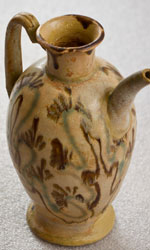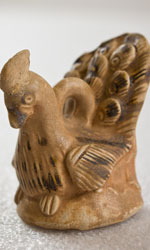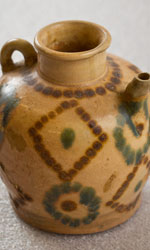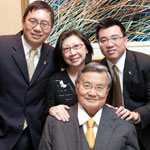A gift of Chinese culture
For more than 25 years, Timothy Lam has been building his collection of Chinese pottery — around 550 pieces that date back more than a thousand years. His treasures now have a new home at Wake Forest University.
Lam, a 1960 Wake Forest graduate, says the highlight of his college education was the anthropology course he took from E. Pendleton Banks in the summer of 1959. Because of the importance of this class in his life, he donated his ceramics to the University’s Museum of Anthropology so that students and members of the community will be able to gain a deeper understanding of Chinese culture.
 The bowls, ewers, cups, teapots, small toys and other pieces in the collection, which dates from the Tang Dynasty (618 to 907 AD), represent the largest, most comprehensive group of unbroken ceramics from this period in the United States.
The bowls, ewers, cups, teapots, small toys and other pieces in the collection, which dates from the Tang Dynasty (618 to 907 AD), represent the largest, most comprehensive group of unbroken ceramics from this period in the United States.
“A ceramic pot is not just a vessel. Each piece in this collection preserves a record of the decisions made by the Chinese artisans. How it was made, how it was meant to be used, and how it was decorated reflect the broader social, economic and political life of China during this period,” says anthropology professor Paul Thacker.
Lam, a Tang ceramics expert, says some of the pieces in his collection are broken (but painstakingly repaired) because, due to slight flaws in shape or glazing, kiln inspectors discarded them by burying them in a refuse pile. Ironically, most of the pieces that passed inspection were sold, used and ultimately broken—meaning they can rarely be fully reconstructed.
Unusual pieces in the collection include water bowls used to rinse ink from pens; specially designed ceramic headrests for sleeping to keep hair neat overnight; and small animal figures that show a variety of species that lived in China at that time.
 “In decoration and design, the pieces look similar to those made by potters today,” says Stephen Whittington, director of the Museum of Anthropology. “The pieces made at the Changsha kilns were used for everyday purposes, but beauty and craftsmanship were as important as functionality. Some of the pieces have poems on them, and some are signed by the family that made them.”
“In decoration and design, the pieces look similar to those made by potters today,” says Stephen Whittington, director of the Museum of Anthropology. “The pieces made at the Changsha kilns were used for everyday purposes, but beauty and craftsmanship were as important as functionality. Some of the pieces have poems on them, and some are signed by the family that made them.”
The collection also comes with an invaluable guide. In 1990, Lam wrote and published a 367 page reference book on the art and archaeology of family kilns, “Tang Ceramics: Changsha Kilns.” The book contains more than 500 hand-drawn illustrations and 200 professional-quality photographs created by the author and contains information about more than 1000 ceramic pieces in the Lam and other collections.
The book will make creating an exhibition easy, says Whittington. “I plan to work with students to showcase a few pieces in an exhibit at the Museum of Anthropology this spring, then to create an exhibit featuring many more pieces over the next couple of years. We will simultaneously create a version that will travel to other museums and galleries, helping to spread the word about Tim Lam and his vast knowledge and commitment to preserving Chinese ceramics from this era.”
 The museum will use the collection to support teaching in anthropology, East Asian language and cultures, history and art, among other academic departments and programs. It will also support K-12 classes on China offered to local schools. Wake Forest students working in the museum or researching pottery-making techniques will gain valuable, hands-on experience working with the collection.
The museum will use the collection to support teaching in anthropology, East Asian language and cultures, history and art, among other academic departments and programs. It will also support K-12 classes on China offered to local schools. Wake Forest students working in the museum or researching pottery-making techniques will gain valuable, hands-on experience working with the collection.
In 1983, Lam was awarded the Alumni Association’s Distinguished Service Citation in Business, and in 1989, he was honored as the 1,000th member of the President’s Club. From 1996-2004, Lam served two terms on the College Board of Visitors. Both his sons graduated from Wake Forest, Tim Jr. in 1993 and Marcus in 1998. Lam lives with his wife, Ellen, in Vienna, Virginia.




